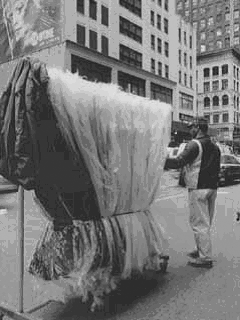

|
Design and Product Development |
Copyright 2006
Cornell
University.
All rights reserved.
|
For example, in a factory making T-shirts, there are a limited number of pieces (front, back, sleeves, pockets, binding) and sewing steps (8 to 12) to complete the T-shirt. In a factory making outerwear jackets for hiking, there are more pieces, interlining and lining, zippers and snaps, and more intricate sewing steps (40-100) than in the T-shirt factory. Manufacturers and contractors try to sew products that are similar in order to
In New York City's Garment District, manufacturers were located according to their product type for most of the 20th century. This gave buyers easy access to production facilities as well as showrooms. For example, when buyers came to NYC to buy women's sportswear, they could see all of the competing products in one or two buildings. This has changed as rents have escalated. More and more apparel businesses have located or relocated outside the Garment District. But the industry is still organized by product type. The U.S. government requires all businesses to report on their activities, including the number of employees and sales figures. This information is organized by industry and is available in a variety of U.S. Census Bureau documents. The North American Industry Classification System (NAICS), formerly known as the SIC codes or Standard Industrial Classification system, classifies businesses together that are similar. NAICS is used by the United States, Canada, and Mexico and for uniformity among the three countries. You will use the NAICS code when filing business reports and taxes. The web site www.census.gov/epcd/www/naics.html can help you understand this system. NAICS categorizes more than 350 new industries into 20 broad sectors. The apparel and sewn product industries are in the manufacturing sector, numbers 31-33. There is also a retailing sector that includes apparel businesses. NAICS uses a six-digit code, rather than the four-digit SIC code.
|
||||||||||||
 The apparel industry has historically divided itself by product type. Manufacturers and contractors that produced apparel defined themselves by their products - e.g., dresses, men's wear, or sportswear businesses. This is logical because the machinery and layout of the factory floor is determined by the production steps that are determined by product type.
The apparel industry has historically divided itself by product type. Manufacturers and contractors that produced apparel defined themselves by their products - e.g., dresses, men's wear, or sportswear businesses. This is logical because the machinery and layout of the factory floor is determined by the production steps that are determined by product type.